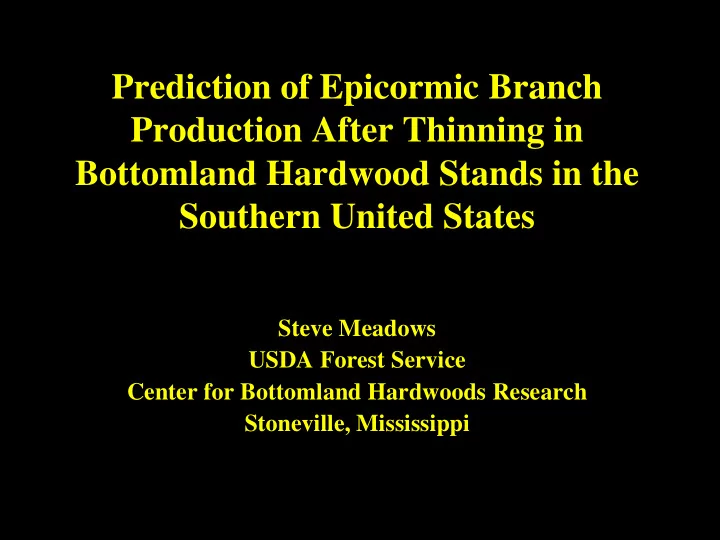

Prediction of Epicormic Branch Production After Thinning in Bottomland Hardwood Stands in the Southern United States Steve Meadows USDA Forest Service Center for Bottomland Hardwoods Research Stoneville, Mississippi
Thinning Objectives • Improve species composition • Improve stand health, quality, and value • Increase growth of residual trees • Enhance quality and value of residual trees
Study Sites • Two sites in Alabama – Westervelt Company • Southeastern Arkansas – Potlatch Corporation • East Texas – Temple-Inland Forest Products
Species Cherrybark oak CBO Quercus pagoda Quercus nigra Water oak WAO Willow oak WIO Quercus phellos
Sample Sizes and Range in DBH (cm) Unthinned Thinned TOTAL Species n Dbh n Dbh Cherrybark oak 79 14-94 150 14-90 229 Water oak 93 14-80 209 16-81 302 Willow oak 187 14-66 376 14-84 563 TOTAL 359 735 1094
Epicormic Branches 16 14 Epicormic Branches 12 10 8 6 4 2 0 0 1 2 3 4 5 6 7 8 9 10 Years Since Thinning CBO Unthinned WAO Unthinned WIO Unthinned CBO Thinned WAO Thinned WIO Thinned
Epicormic Branches Cherrybark Oak 16 14 Epicormic Branches 12 10 8 6 4 2 0 0 1 2 3 4 5 6 7 8 9 10 Years Since Thinning D/CD Unthinned INT Unthinned D/CD Thinned INT Thinned
Epicormic Branches Water Oak 16 14 Epicormic Branches 12 10 8 6 4 2 0 0 1 2 3 4 5 6 7 8 9 10 Years Since Thinning D/CD Unthinned INT Unthinned D/CD Thinned INT Thinned
Epicormic Branches Willow Oak 16 14 Epicormic Branches 12 10 8 6 4 2 0 0 1 2 3 4 5 6 7 8 9 10 Years Since Thinning D/CD Unthinned INT Unthinned D/CD Thinned INT Thinned
Epicormic Branches Dominant/Codominant 16 14 Epicormic Branches 12 10 8 6 4 2 0 0 1 2 3 4 5 6 7 8 9 10 Years Since Thinning CBO Unthinned WAO Unthinned WIO Unthinned CBO Thinned WAO Thinned WIO Thinned
Epicormic Branches at Year 9 Dominant/Codominant Simple Linear Regression – r 2 CBO WAO WIO Unthin Thin Unthin Thin Unthin Thin Initial DBH 0.23 0.10 0.23 0.07 0.37 0.23 Initial Epics 0.49 0.13 0.32 0.43 0.81 0.46 Residual BA -- 0.03 -- 0.02 -- 0.02 Percent Cut -- 0.01 -- 0.05 -- 0.04
Epicormic Branches at Year 9 Dominant/Codominant 30 Epicormic Branches 25 20 15 10 5 0 0 5 10 15 20 25 Pre-Existing Epicormic Branches CBO Unthinned WAO Unthinned WIO Unthinned CBO Thinned WAO Thinned WIO Thinned
Epicormic Branches at Year 9 Dominant/Codominant – Thinned Only E 9 = 5.11 + 0.93(E 0 ) – 0.08(D 0 ) r 2 =0.18 CBO r 2 =0.49 WAO E 9 = 0.32 + 1.10(E 0 ) + 0.19(%BA) - 0.07(D 0 ) E 9 = (-9.86) + 0.73(E 0 ) – 0.21(D 0 ) + 0.32(%BA) r 2 =0.56 WIO + 0.67(BA RES )
Preliminary Conclusions • Species differed in the number of epicormic branches produced on the butt log in both unthinned and thinned stands • Crown class (indicator of tree health) strongly influenced production of epicormic branches • Number of pre-existing epicormic branches was the most accurate single-variable predictor of epicormic branch production in dominant and codominant trees of all three species
Preliminary Conclusions • Stand density variables had little or no effect on epicormic branch production in dominant and codominant trees after thinning – especially true for cherrybark oak • Multiple regression did not greatly improve the prediction model relative to the simple regression model with number of pre-existing epicormic branches as the single independent variable
Factors Affecting Epicormic Branching Species Stress Sunlight
Questions? Steve Meadows smeadows01@fs.fed.us Merci beaucoup, y’all !!
Recommend
More recommend